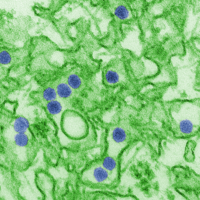
Photo from wikipedia
ETHNOPHARMACOLOGICAL RELEVANCE Dengue virus (DENV) is a re-emerging mosquito-borne Flavivirus that has recently engendered large epidemics around the world. Consequently antivirals with effective anti-DENV therapeutic activity are urgently required. In… Click to show full abstract
ETHNOPHARMACOLOGICAL RELEVANCE Dengue virus (DENV) is a re-emerging mosquito-borne Flavivirus that has recently engendered large epidemics around the world. Consequently antivirals with effective anti-DENV therapeutic activity are urgently required. In the 18th century, Europeans, as well as native inhabitants of North America, were known to adapt the medicinal property of the common perennial plant Eupatorium perfoliatum L. to treat fever and infections. Previous studies have shown that Eupatorium perfoliatum L. possesses anti-inflammatory, anti-oxidative, anti-plasmodial, anti-bacterial and antiviral activities. However, to the best of our knowledge, no anti-DENV activity of E. perfoliatum L. had been investigated at the molecular level so far. AIM OF STUDY Here, first time we have attempted to study the action of E. perfoliatum extract and its few bioactive components i.e., quercetin, caffeic acid and eupafolin against wild primary clinical isolate of DENV-2 infection in an in vitro model. MATERIALS AND METHODS The presence of the bioactive components in the E. perfoliatum extract, were analyzed by HPLC- DAD. Then, CC50 as well as IC50 values of the extract and its bioactive components were measured against DENV in HepG2 cell line. After that, the antiviral activity was studied by Time of addition assay using qRT-PCR. Further, the downstream signalling action of E. perfoliatum extract, was studied by Human phosphorylation MAPK antibody array, followed by immunofluorescence microscopy. Moreover, a molecular docking analysis was done to study the binding affinity of bioactive components of E. perfoliatum extract with TIM-1 transmembrane receptor protein, which is known for viral internalization. RESULT We found that E. perfoliatum extract has marked antiviral activity during pre-treatment against DENV infection in HepG2 cell line. The extract also significantly reduced the DENV induced autophagy in HepG2 cell line as detected by LC3 II localization. The presence of different bioactive compounds in E. perfoliatum extract were confirmed by HPLC-DAD. In the bioactive components, in parallel to earlier studies, quercetin showed the most significant preventive action against DENV infection. Further, in molecular docking analysis also, quercetin showed the strongest binding affinity towards DENV membrane receptor TIM-1 protein. CONCLUSION Our findings suggests that E. perfoliatum extract has significant potential to be an anti-DENV therapeutic agent. Moreover, among the bioactive components, quercetin may have a prophylaxis role in executing the antiviral activity of E. perfoliatum extract against DENV infection.
Journal Title: Journal of ethnopharmacology
Year Published: 2021
Link to full text (if available)
Share on Social Media: Sign Up to like & get
recommendations!